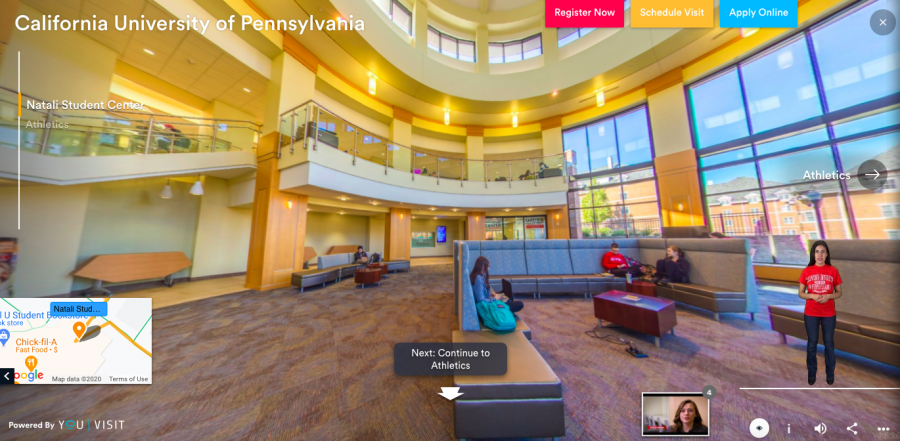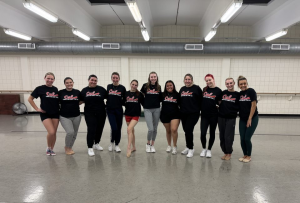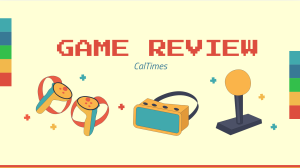How to choose the right college in a pandemic
Questions to ask about college during COVID-19 and how to find the answers
A tour guide introduces Cal U’s Natali Student Center on the virtual tour offered as part of the “Experience Cal U” section of the university’s website at www.calu.edu/visit.
October 1, 2020
For high school juniors and seniors, selecting a college to attend is no easy task, and now COVID-19 has added safety, accessibility and financial concerns to worries of standardized tests, college essays and applying for scholarships. Students have even more to consider due to the pandemic as subsequent changes have effected what in what secondary education means.
Read on to learn what educators, administrators and students have prioritized in this year’s college selection process and how to use new tools to help find a perfect match.
Virtual Considerations
Check out the online resources offered by both your high school and colleges under consideration.
According to California Area High School guidance counselor Nadia Uhall, it is around this time of the year when college representatives visit high schools and speak with prospective students. However, due to safety restrictions, many of these visits have been moved from in-person to online.
“I probably have 10-15 [representatives] wanting to schedule a visitation,” Uhall said. “It’s very likely that all of those will be remote so they are doing their visitations via Zoom.”
Uhall also said that she has learned to create more interactive components, such as hyperlinks in the forms of Bitmojis, to her guidance page and emails sent to students to help to distribute information. She encouraged students to stay up–to–date with their high school’s offered online resources which can include databases of career exploration, local university information and scholarship applications.
“We’re relying more heavily on electronic forms of communication so email, social media, Google classroom, Remind.com, things of that nature,” Uhall said.
As for the high school students themselves, instead of driving hours to be shown around by uniformed tour guides, the typical college visits have also been moved online.
General Mclane High School senior Aralyn Lewin, 18, said that the university she is looking at offered a virtual tour of the campus.
“It was nice,” she said. “They also offer in-person tours in small groups, but some people don’t have the time or can’t visit schools during COVID.”
Cal U assistant director of admissions, Barry Bilitski, said he and other admissions counselors have been doing car tours all summer in place of in-person tours.
“I think the hardest part for students and families is not being able to visit some colleges in person to see and feel the atmosphere of a typical day on a college campus,” he said. “Although, Cal U is doing some really cool things now so students can visit virtually or in person,”
Bilitski also encouraged students to visit Cal U’s website to explore alternative ways to “see” the campus.
College freshman Derrek Harshberger, 18, said he attended Cal U’s accepted student day virtually.
“It was a different experience due to it being online however I received tons of information to prepare me for the upcoming semester,” he said.
Things to Look For
SAT/ACT Waiver
Research what application requirements have changed. Some universities have been waiving the typical SAT/ACT score requirement to help alleviate stress for applying high school students.
“Because of the pandemic, Cal U is now ‘test optional” in the admissions process,” Bilitski said. “So many students did not have the opportunity to take the SAT or ACT, so we are not requiring a standardized test for the 2021 seniors.”
Lewin said that she’s glad to not have to worry about the tests as things have been extremely hectic and socially distanced standardized tests would be complicated.
“It’s good to know what the schools you’re looking at have changed in their application,” Lewin said. “Otherwise, you’d be doing all this work for no reason, but I’m really glad that I don’t have to take the SATs again.”
COVID-19 Measures
When looking at schools, Lewin has also been conscious of how the pandemic and possible remote learning has been and is being handled.
“All of the school websites I’ve looked at have nothing on COVID information unless you go under ‘current students,’” Lewin said. “Which doesn’t make sense, but you definitely have to go looking for it.”
Some things Lewin has investigated because of the pandemic have been how schools are enforcing safety, if and how much tuition will change if moved online and what is planned for the spring semester.
COVID-19 Scholarships
Another resource to consider is scholarships pertaining to the class 2021 experiencing their senior year during the COVID-19 pandemic. Lewin said many are focused on ‘how the pandemic has impacted you?’ and that many are available. The ScholarshipOwl “Study in Isolation Relief” scholarship awards up to $1,000 for telling your COVID-19 story of studying from home. Similarly, the “Income Loss Fund” gives up to $1,000 to students who have lost their side income due to the pandemic.
Be Flexible
The pandemic has been nothing short of unexpected, according to Uhall. Because of this, she said she is encouraging her students to be more comfortable thinking short-term. Universities have bounced back and forth between being in-person to online classes for months.
“Students are so used to thinking months ahead, but we really don’t know what will be decided,” said Uhall.
Harshberger echo’s this mentality. He urges students to not let a pandemic slow their progress.
“Get [college applications] done and turned in and apply for as many scholarships as possible,” Harshberger said. “It may seem like you won’t get into that certain college or be awarded a certain scholarship, but you can never know for sure unless you tried, and you tried your hardest.”
And though high school seniors may not be able to dance at homecoming or cheer from student sections at sports functions, they remain united as the class of 2021.
“We really don’t know what will happen in the spring, what will change,” Lewin said. “This puts a lot of stress on the student body, but we can’t change anything. All we can do is continue living and enjoying the time we have together.”







